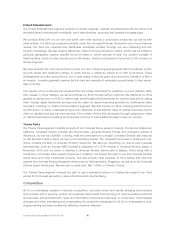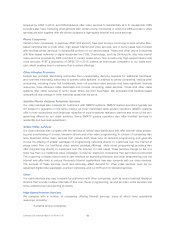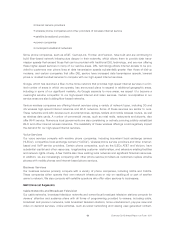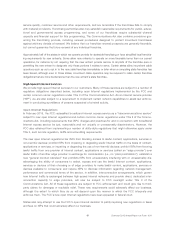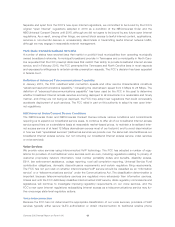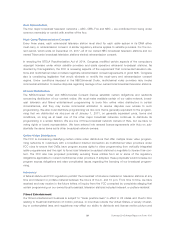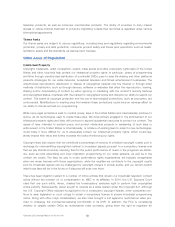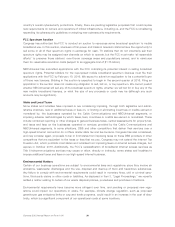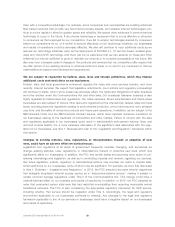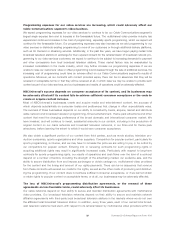Comcast 2015 Annual Report Download - page 22
Download and view the complete annual report
Please find page 22 of the 2015 Comcast annual report below. You can navigate through the pages in the report by either clicking on the pages listed below, or by using the keyword search tool below to find specific information within the annual report.
company networks by contracting with an existing CLEC, which has the right, as a telecommunications car-
rier, to request and obtain interconnection with the traditional wireline phone companies. We have arranged
for such interconnection rights through affiliated CLECs. If a regulatory or judicial authority were to deny our
ability to interconnect through one of our affiliated CLECs, our ability to provide voice services and compete
in the area in question would be negatively impacted. The FCC regulates the arrangements by which tele-
communications carriers compensate one another for exchanged traffic, and has affirmed the right of CLECs
to collect intercarrier compensation when providing interconnection for VoIP providers. In 2012, the FCC
sought comment on petitions that raise issues concerning the interconnection obligations for VoIP providers.
Further, a Massachusetts state commission is reviewing whether IP interconnection agreements should be
subject to regulation and other states could follow.
Universal Service
A federal program known as the Universal Service program generally requires telecommunications service
providers to pay a fee based on revenue from their services into a fund used to subsidize the provision of
telecommunications services in high-cost areas and to low-income consumers and the provision of Internet
and telecommunications services to schools, libraries and certain health care providers. Some states also
have analogous programs that support service in high-cost areas or to low-income consumers. The FCC has
long considered implementing changes to the Universal Service program, such as changing the fee calcu-
lation from a revenue-based formula to a per-user fee or per-connection fee, adopting a fee based on
bandwidth, and expanding the services subject to the fee to include broadband Internet access services. In
2014, the FCC referred the question of how to reform Universal Service fees to a joint federal and state
commission, which was expected to make a recommendation in 2015, but has not yet done so.
The FCC recently has shifted its focus away from supporting traditional telephone service, and toward sub-
sidizing broadband deployment. This shift could assist some of our competitors. For example, in 2014, the
FCC substantially revised the program that provides Universal Service support for services to schools and
libraries to shift support from voice services to broadband services and the deployment of Wi-Fi networks.
NBCUniversal Segments
Cable Networks
Program Access
The Communications Act and FCC regulations (i.e., the “program access rules”) generally prevent cable
networks affiliated with cable operators from favoring cable operators over competing multichannel video
programming distributors (“MVPDs”). The FCC is considering whether certain online video distributors
(“OVDs”) should be classified as MVPDs, which would give them the ability to bring complaints under the
program access rules.
The FCC and Congress also have considered proposals that would require companies that own multiple
cable networks to make each of their networks available individually when negotiating distribution agreements
with multichannel video providers and potentially with OVDs. We currently offer our cable networks both on a
bundled basis and, when requested, individually.
Under the terms of the NBCUniversal Order, MVPDs can invoke commercial arbitration for access in certain
circumstances to our cable networks and broadcast television networks, including our regional sports net-
works. In addition, under the NBCUniversal Order and NBCUniversal Consent Decree, we are required to
make certain of our cable network, broadcast television and filmed entertainment programming available to
bona fide OVDs in certain circumstances. For further discussion of these conditions, see “Broadcast Tele-
vision” below and refer to the “Must-Carry/Retransmission Consent” and “Internet Distribution” discussions
within that section.
19 Comcast 2015 Annual Report on Form 10-K



